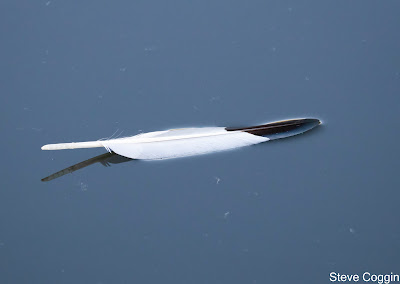 |
| Juvenile Pied-billed Grebe (Podilymbus podiceps). Green Cay Wetlands, Palm Beach County, Florida. |
Diane and I visited south Florida in August. It was hot. The low temperatures at night were in the 80s and it went up from there. These were not the best conditions for nature observation. Birds were quiet and mammals were hiding out, but we went out each day to visit wetlands. Even in these steamy conditions we saw some interesting sights.
 |
| Adult Pied-billed Grebe feeding young. Green Cay Wetlands, Palm Beach County, Florida. |
Many of the birds were still taking care of their last brood of the year. An adult Pied-billed Grebe (Podilymbus podiceps) was teaching its two babies to catch fish. The adult would dive, bring up a fish and drop it and let the juveniles try their hand at fishing. This went on for at least 20 minutes and the fish was getting a little worse for wear by the time we left. The young Pied-billed Grebes had a striking color pattern with gold, black and white stripes on their heads and pink at the base of their pied bills.
 |
| Common Gallinule (Gallinula galeata). Green Cay Wetlands, Palm Beach County, Florida. |
 |
| Adult and juvenile Common Gallinules. Wakodahatchee Wetlands, Palm Beach County, Florida. |
Common Gallinules (Gallinula galeata) and were also busy raising their young. A baby Common Gallinule still had some downy black feathers and a partially bare head. Its beak was yellow with a black mark and just a hint of red at the base. The parent by contrast was dark gray with a yellow-tipped red beak. Above the beak adult Common Gallinules had a red shield. This structure is found in certain members of the Rail family, the Ralllidae, and probably functions in attracting mates. Another striking feature of adult Common Gallinules was their legs and feet. The toes are long allowing the birds to easily walk across floating vegetation. The legs and toes are bright yellow with a red band near the body.
 |
| An Black-bellied Whistling Duck (Dendrocygna autumnalis) admiring the sunrise. Green Cay Wetlands, Palm Beach County, Florida. |
Back-bellied Whistling Ducks (Dendrocygna autumnalis) were leading their latest offspring. An adult was waddling through the shallows being trailed by a line of rather large ducklings. These handsome ducks have a gray head, brown body, a pink beak and, of course, a black belly. The young ducks look much like adults but with a gray beak. Black-bellied Whistling Ducks were formerly found in the American tropics but have expanded their range through the southern and eastern United States and north into Canada.
 |
| Adult and juvenile Black-bellied Whistling Ducks. Wakodahatchee Wetlands, Palm Beach County, Florida. |
 |
| Least Bittern (Ixobrychus exilis). Green Cay Wetlands, Palm Beach County, Florida. |
Dragonflies were active in the summer heat. These voracious predators flew across the marsh searching for insects and would briefly perch on the tips of plants. Brilliant Blue Dashers (Pachydiplax longipennis) were common with their bright blue bodies and emerald eyes.
 |
| A male Blue Dasher (Pachydiplax longipennis). Green Cay Wetlands, Palm Beach County, Florida. |
Four-spotted Pennants (Brachymesia gravida) were abundant in the marsh. Their common name comes from the dark spot on each of the dragonfly's four wings. They also have a small white spots called stigma on the leading edge near the tip of the wings.
 |
| Four-spotted Pennant (Brachymesia gravida). This is a female with light brown wing spots. Green Cay Wetlands, Palm Beach County, Florida. |
The most dramatic dragonflies we saw were the Halloween Pennants (Celithemis eponina). The males are orange with brown wing spots. This color pattern is reminiscent of Halloween decorations and gives the insect its name. Females are a little less orange but still have the dark wing spots. Halloween Pennants have the curious habit of perching with their front and back wings held at different angles.
 |
| Halloween Pennant (Celithemis eponina). Green Cay Wetlands, Palm Beach County, Florida. |
 |
| Halloween Pennant. Green Cay Wetlands, Palm Beach County, Florida. |
On a boardwalk that crossed a pond, we saw feathers floating on the water. The first feather was a primary, white with a black tip. It was from a White Ibis (Eudocimus albus). I thought it had been dropped by a molting bird since they replace their feathers after the breeding season. Then other feathers started drifting by. There were more primaries, then secondaries, then body feathers. This peaceful sight of floating feathers started to look like something darker. Like leftovers from an alligator's meal.
 |
| White Ibis (Eudocimus albus). Wakodahatchee Wetlands, Palm Beach County, Florida. |
 |
| White Ibis primary feather floating. Green Cay Wetlands, Palm Beach County, Florida. |
 |
| White Ibis body feather floating. Green Cay Wetlands, Palm Beach County, Florida. |
It was fun going out on those slow, hot Florida days. Several people told us, “Come back in
October, when the weather is nicer.” We
will.
Great photos!
ReplyDelete